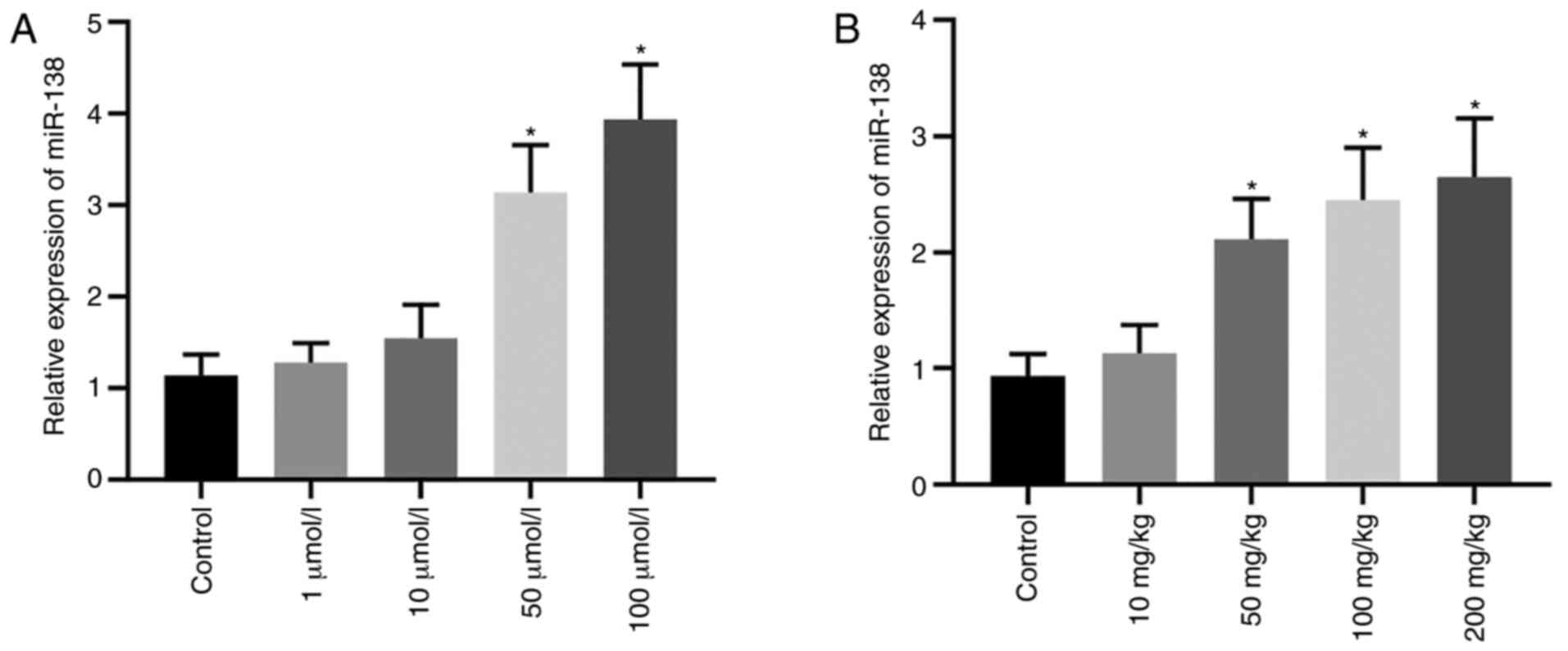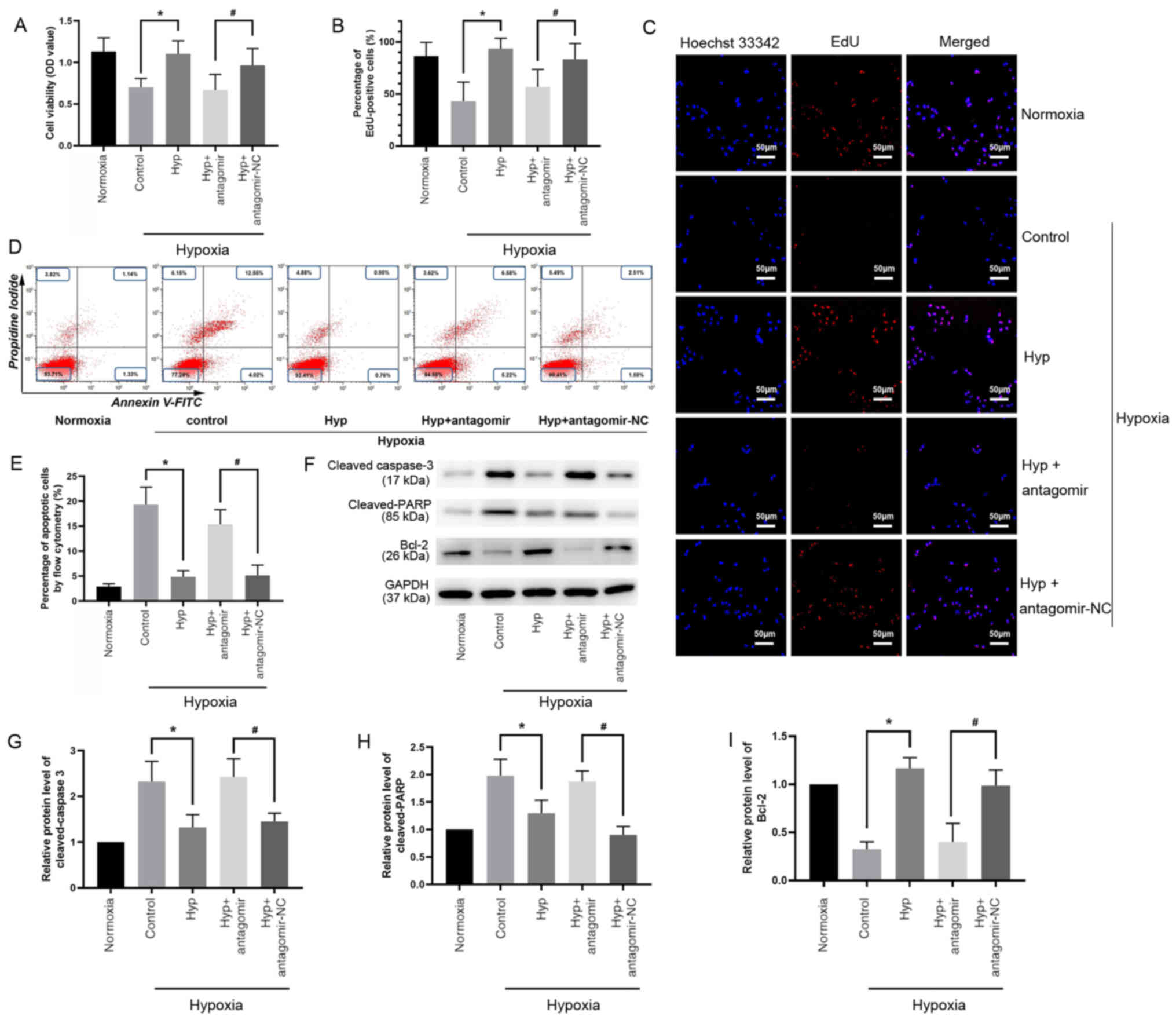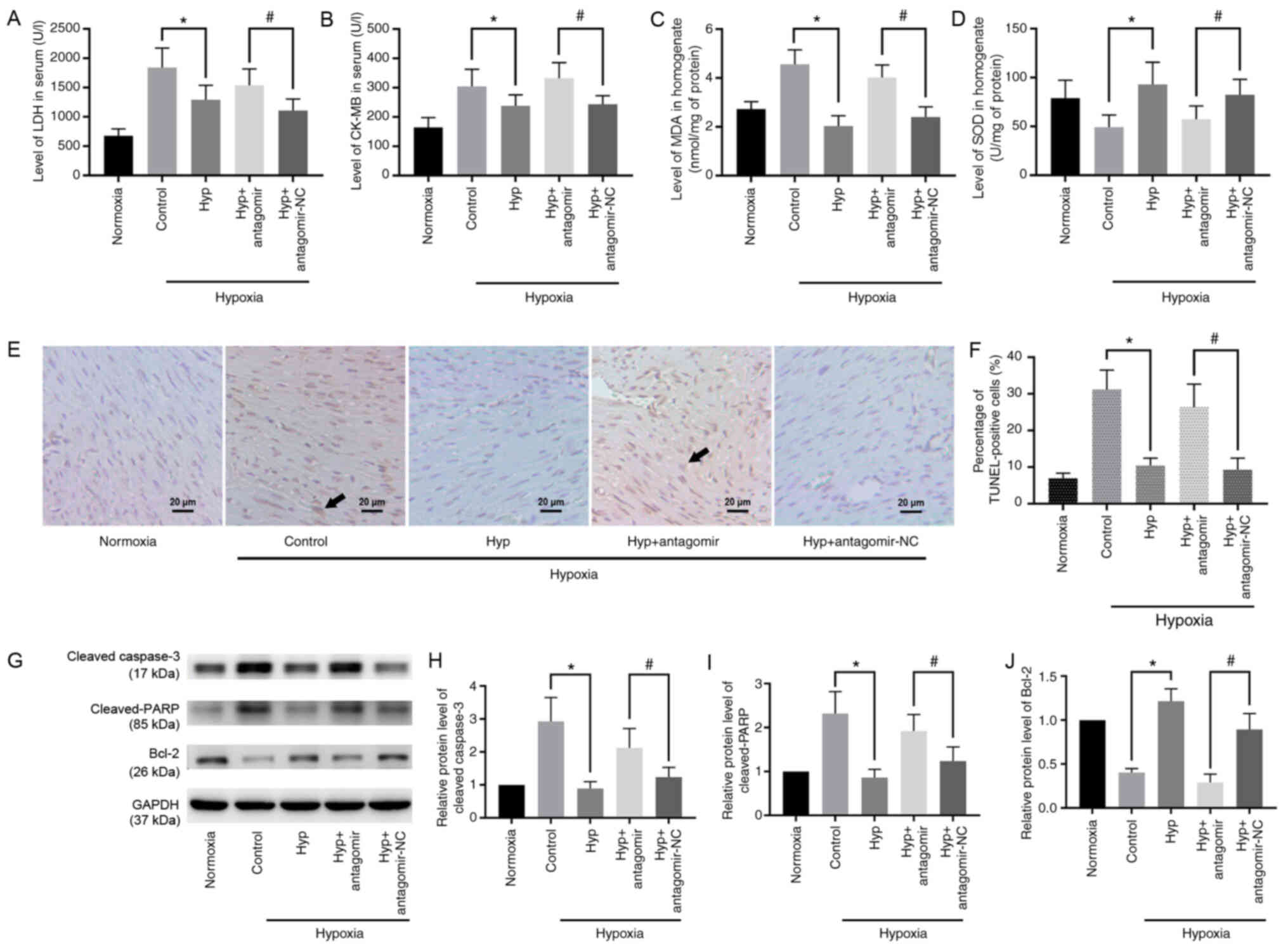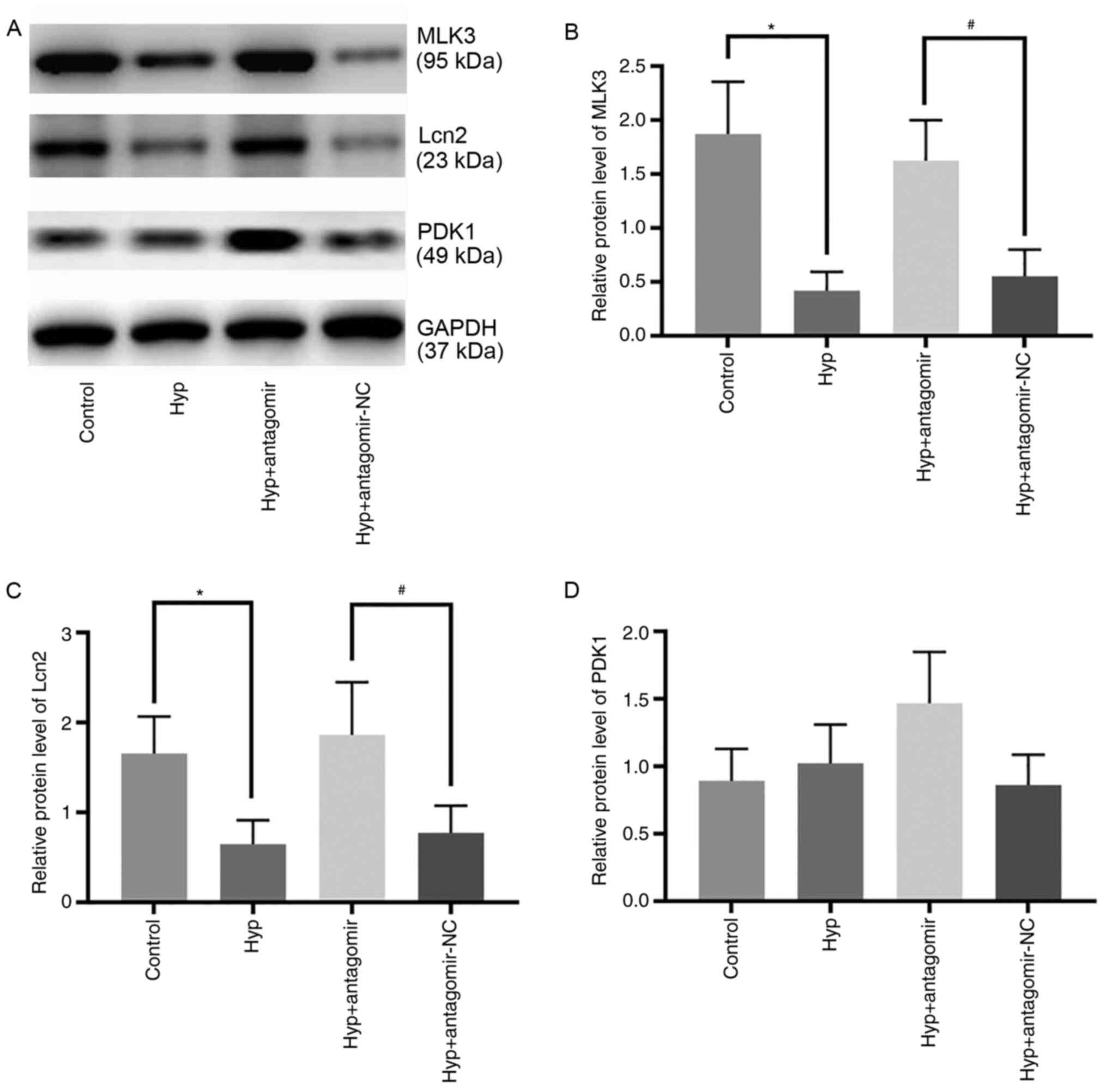|
1
|
Azzouzi HE, Leptidis S, Doevendans PA and
De Windt LJ: HypoxamiRs: Regulators of cardiac hypoxia and energy
metabolism. Trends Endocrinol Metab. 26:502–508. 2015. View Article : Google Scholar : PubMed/NCBI
|
|
2
|
Qiu Q, Shen T, Wang Q, Yu X, Jia N and He
Q: Cardiac shock wave therapy protects cardiomyocytes from
hypoxia-induced injury by modulating miR-210. Mol Med Rep.
21:631–640. 2020.PubMed/NCBI
|
|
3
|
Zhang P: Advantages, disadvantages, and
trend of integrative medicine in the treatment of heart failure.
Cell Biochem Biophys. 72:363–366. 2015. View Article : Google Scholar : PubMed/NCBI
|
|
4
|
Lin F, Chen HW, Zhao GA, Li Y, He XH,
Liang WQ, Shi ZL, Sun SY, Tian PP, Huang MY and Liu C: Advances in
research on the circRNA-miRNA-mRNA network in coronary heart
disease treated with traditional chinese medicine. Evid Based
Complement Alternat Med. 2020:80486912020. View Article : Google Scholar : PubMed/NCBI
|
|
5
|
Zhang L, Dai Q, Hu L, Yu H, Qiu J, Zhou J,
Long M, Zhou S and Zhang K: Hyperoside alleviates high
glucose-induced proliferation of mesangial cells through the
inhibition of the ERK/CREB/miRNA-34a signaling pathway. Int J
Endocrinol. 2020:13619242020. View Article : Google Scholar : PubMed/NCBI
|
|
6
|
Li ZL, Hu J, Li YL, Xue F, Zhang L, Xie
JQ, Liu ZH, Li H, Yi DH, Liu JC and Wang SW: The effect of
hyperoside on the functional recovery of the ischemic/reperfused
isolated rat heart: Potential involvement of the extracellular
signal-regulated kinase 1/2 signaling pathway. Free Radic Biol Med.
57:132–140. 2013. View Article : Google Scholar : PubMed/NCBI
|
|
7
|
Hou JY, Liu Y, Liu L and Li XM: Protective
effect of hyperoside on cardiac ischemia reperfusion injury through
inhibition of ER stress and activation of Nrf2 signaling. Asian Pac
J Trop Med. 9:76–80. 2016. View Article : Google Scholar : PubMed/NCBI
|
|
8
|
Xiao R, Xiang AL, Pang HB and Liu KQ:
Hyperoside protects against hypoxia/reoxygenation induced injury in
cardiomyocytes by suppressing the Bnip3 expression. Gene.
629:86–91. 2017. View Article : Google Scholar : PubMed/NCBI
|
|
9
|
Kalayinia S, Arjmand F, Maleki M,
Malakootian M and Singh CP: MicroRNAs: Roles in cardiovascular
development and disease. Cardiovasc Pathol. 50:1072962021.
View Article : Google Scholar : PubMed/NCBI
|
|
10
|
He S, Liu P, Jian Z, Li J, Zhu Y, Feng Z
and Xiao Y: miR-138 protects cardiomyocytes from hypoxia-induced
apoptosis via MLK3/JNK/c-jun pathway. Biochem Biophys Res Commun.
441:763–769. 2013. View Article : Google Scholar : PubMed/NCBI
|
|
11
|
Xiong H, Luo T, He W, Xi D, Lu H, Li M,
Liu J and Guo Z: Up-regulation of miR-138 inhibits hypoxia-induced
cardiomyocyte apoptosis via down-regulating lipocalin-2 expression.
Exp Biol Med (Maywood). 241:25–30. 2016. View Article : Google Scholar : PubMed/NCBI
|
|
12
|
Zhu H, Xue H, Jin QH, Guo J and Chen YD:
miR-138 protects cardiac cells against hypoxia through modulation
of glucose metabolism by targetting pyruvate dehydrogenase kinase
1. Biosci Rep. 37:BSR201702962017. View Article : Google Scholar : PubMed/NCBI
|
|
13
|
Council N: Guide for the Care and Use of
Laboratory Animals: Eighth Edition. Publication. 327:963–965.
2011.
|
|
14
|
Livak KJ and Schmittgen TD: Analysis of
relative gene expression data using real-time quantitative PCR and
the 2(-Delta Delta C(T)) method. Methods. 25:402–408. 2001.
View Article : Google Scholar : PubMed/NCBI
|
|
15
|
Wu L, Li Q, Liu S, An X, Huang Z, Zhang B,
Yuan Y and Xing C: Protective effect of hyperoside against renal
ischemia-reperfusion injury via modulating mitochondrial fission,
oxidative stress, and apoptosis. Free Radic Res. 53:727–736. 2019.
View Article : Google Scholar : PubMed/NCBI
|
|
16
|
Shi Y, Qiu X, Dai M, Zhang X and Jin G:
Hyperoside attenuates hepatic ischemia-reperfusion injury by
suppressing oxidative stress and inhibiting apoptosis in rats.
Transplant Proc. 51:2051–2059. 2019. View Article : Google Scholar : PubMed/NCBI
|
|
17
|
Wang X, Fan G, Wei F, Bu Y and Huang W:
Hyperoside protects rat ovarian granulosa cells against hydrogen
peroxide-induced injury by sonic hedgehog signaling pathway. Chem
Biol Interact. 310:1087592019. View Article : Google Scholar : PubMed/NCBI
|
|
18
|
Kwon SH, Lee SR, Park YJ, Ra M, Lee Y,
Pang C and Kim KH: Suppression of 6-hydroxydopamine-induced
oxidative stress by hyperoside via activation of Nrf2/HO-1
signaling in dopaminergic neurons. Int J Mol Sci. 20:58322019.
View Article : Google Scholar
|
|
19
|
Rodius S, de Klein N, Jeanty C,
Sánchez-Iranzo H, Crespo I, Ibberson M, Xenarios I, Dittmar G,
Mercader N, Niclou SP and Azuaje F: Fisetin protects against
cardiac cell death through reduction of ROS production and caspases
activity. Sci Rep. 10:28962020. View Article : Google Scholar : PubMed/NCBI
|
|
20
|
Loor G and Schumacker PT: Role of
hypoxia-inducible factor in cell survival during myocardial
ischemia-reperfusion. Cell Death Differ. 15:686–690. 2008.
View Article : Google Scholar : PubMed/NCBI
|
|
21
|
Li JP, Liao XH, Xiang Y, Yao A, Song RH,
Zhang ZJ, Huang F, Dai ZT and Zhang TC: Hyperoside and let-7a-5p
synergistically inhibits lung cancer cell proliferation via
inducing G1/S phase arrest. Gene. 679:232–240. 2018. View Article : Google Scholar : PubMed/NCBI
|
|
22
|
Li W, Liu M, Xu YF, Feng Y, Che JP, Wang
GC and Zheng JH: Combination of quercetin and hyperoside has
anticancer effects on renal cancer cells through inhibition of
oncogenic microRNA-27a. Oncol Rep. 31:117–124. 2014. View Article : Google Scholar : PubMed/NCBI
|
|
23
|
Zhang L, He S, Yang F, Yu H, Xie W, Dai Q,
Zhang D, Liu X, Zhou S and Zhang K: Hyperoside ameliorates
glomerulosclerosis in diabetic nephropathy by downregulating
miR-21. Can J Physiol Pharmacol. 94:1249–1256. 2016. View Article : Google Scholar : PubMed/NCBI
|
|
24
|
Zhang X, Qin Q, Dai H, Cai S, Zhou C and
Guan J: Emodin protects H9c2 cells from hypoxia-induced injury by
up-regulating miR-138 expression. Braz J Med Biol Res.
52:e79942019. View Article : Google Scholar : PubMed/NCBI
|
|
25
|
Li Y, Li J, Zhang P, Jiang X, Pan Z, Zheng
W and Lin H: lncRNA-LET relieves hypoxia-induced injury in H9c2
cells through regulation of miR-138. J Cell Biochem. 121:259–268.
2020. View Article : Google Scholar : PubMed/NCBI
|
|
26
|
Li JB, Wang HY, Yao Y, Sun QF, Liu ZH, Liu
SQ, Zhuang JL, Wang YP and Liu HY: Overexpression of microRNA-138
alleviates human coronary artery endothelial cell injury and
inflammatory response by inhibiting the PI3K/Akt/eNOS pathway. J
Cell Mol Med. 21:1482–1491. 2017. View Article : Google Scholar : PubMed/NCBI
|
|
27
|
Shi S, Zhang S, Zhang H, Jin Q and Wu D:
Silencing circANKRD36 protects H9c2 cells against
lipopolysaccharide-induced injury via up-regulating miR-138. Exp
Mol Pathol. 111:1043002019. View Article : Google Scholar : PubMed/NCBI
|
|
28
|
Liu Y, Zou J, Liu X and Zhang Q:
MicroRNA-138 attenuates myocardial ischemia reperfusion injury
through inhibiting mitochondria-mediated apoptosis by targeting
HIF1-α. Exp Ther Med. 18:3325–3332. 2019.PubMed/NCBI
|
|
29
|
Treiber T, Treiber N and Meister G:
Regulation of microRNA biogenesis and its crosstalk with other
cellular pathways. Nat Rev Mol Cell Biol. 20:5–20. 2019. View Article : Google Scholar : PubMed/NCBI
|
|
30
|
He S, Liu S, Wu X, Xin M, Ding S, Xin D,
Ouyang H and Zhang J: Protective role of downregulated MLK3 in
myocardial adaptation to chronic hypoxia. J Physiol Biochem.
73:371–380. 2016. View Article : Google Scholar : PubMed/NCBI
|
|
31
|
Moschen AR, Adolph TE, Gerner RR, Wieser V
and Tilg H: Lipocalin-2: A master mediator of intestinal and
metabolic inflammation. Trends Endocrinol Metab. 28:388–397. 2017.
View Article : Google Scholar : PubMed/NCBI
|
|
32
|
Xu G, Ahn J, Chang S, Eguchi M, Ogier A,
Han S, Park Y, Shim C, Jang Y, Yang B, et al: Lipocalin-2 induces
cardiomyocyte apoptosis by increasing intracellular iron
accumulation. J Biol Chem. 287:4808–4817. 2012. View Article : Google Scholar : PubMed/NCBI
|
|
33
|
Yndestad A, Landrø L, Ueland T, Dahl CP,
Flo TH, Vinge LE, Espevik T, Frøland SS, Husberg C, Christensen G,
et al: Increased systemic and myocardial expression of neutrophil
gelatinase-associated lipocalin in clinical and experimental heart
failure. Eur Heart J. 30:1229–1236. 2009. View Article : Google Scholar : PubMed/NCBI
|
|
34
|
Calleja V, Laguerre M, de Las
Heras-Martinez G, Parker PJ, Requejo-Isidro J and Larijani B: Acute
regulation of PDK1 by a complex interplay of molecular switches.
Biochem Soc Trans. 42:1435–1440. 2014. View Article : Google Scholar : PubMed/NCBI
|
|
35
|
Kaplon J, Zheng L, Meissl K, Chaneton B,
Selivanov VA, Mackay G, van der Burg SH, Verdegaal EM, Cascante M,
Shlomi T, et al: A key role for mitochondrial gatekeeper pyruvate
dehydrogenase in oncogene-induced senescence. Nature. 498:109–112.
2013. View Article : Google Scholar : PubMed/NCBI
|


















